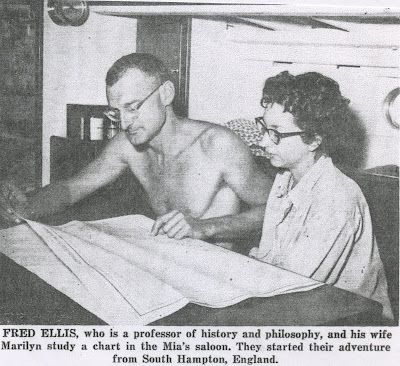 |
| from Aruba Esso News. 22 April 1961. |
Such a man is Fred Ellis who, with his wife Marilyn, called at Aruba recently after having successfully crossed the Atlantic in a 43-ft cutter. They arrived at Oranjestad Harbor 18 march, purely by chance, with eight months of sailing behind them. A malfunctioning salt-water pump interrupted the final leg of their long cruise. Instead of sailing on to Panama, they stopped at Aruba for repairs.
"In a way, it was a fortunate break-down," said Fred Ellis. "We simply love Aruba. We think it's wonderful and a fitting place to end our journey." Again, the seafarers hadn't planned to terminate their adventure in Aruba but time was running out. Dr. Ellis, a professor of history and philosophy, has to be at the U of British Columbia in Vancouver, B.C., in early June--time enough to ship his cutter to his home in Puget Sound but not time enough to sail it there. It would take four months of hard sailing.
The story of the Ellis' memorable Atlantic crossing didn't start 21 July 1960, the day they sailed out of South Hampton, England. Instead, it had its beginning in the remote jungles of Burma where Dr. Ellis served during WW II. Although he had sailed as a child in Portland, OR., it was the crossing of the Pacific on a Liberty ship that gave him the longing to cross an ocean himself.
Separated from the service, he went on to complete his education which led to teaching jobs in Eastern schools. In 1954, he joined the U of Minnesota and ultimately became a full professor. "There is no tidewater 2,000 inland," he said. "While at the university, I had only the Mississippi for sailing and it was just too tame." He longed to return to the sea, especially in the Portland area. In 1960, his big chance came.
"I was offered the position in Vancouver –– just hours from the Puget Sound ––and took it. The prospects of going back to the Pacific coast are wonderful," Dr. Ellis said.
"During those years from 1944 to early last year [1960,] I spent many, many hours planning this trip. I had been allowed to practice navigation on that crowded Liberty ship by a kindly first mate. After the war, I began reading everything remotely connected with boat building, auxiliary engines, sailing, chart reading, radio, currents, favorable winds, ocean crossings in small boats, and survival at sea," he continued. A savings program started several years ago, ultimately went into the building of the Mia; uncounted hours went into the planning and design.
Two years ago, Dr. Ellis got a sabbatical leave and a leave of absence from the U of Minnesota. Accompanied by his wife and four small youngsters, he went to England to supervise the building of the Mia, named after the Arabic word for water.
Much thought and the best materials went into the life rails, saloon, forward quarters, and survival gear lashed to the aft deck. Installed were a radio direction finder, radiotelephone, and a special freshwater trank. In eighteen months the Mia was as nearly perfect as a sailing ship can be. "We had much confidence in the Mia. That was half the battle won. I knew that even if both of us were flat on our backs with sickness at sea, the Mia would carry us through," the deeply tanned professor said.
The Mia is of cutter design with one main mast and two headsails forward. She has a thirty HP diesel auxiliary engine.
 |
Courtesy of Bob and Mary Schoen, the second owners of the MIA, keeping her part of life in the San Juan Islands. |
They made the 1500-mile cruise to Madeira from South Hampton in just 21 days, then spent several weeks visiting various islands in the Canary group. the 2,000-mile voyage from there to Barbados took just 24 days. A young Englishman served as the third crew member from England to Madeira. A young German replace him and served until the Mia reached Bridgetown, Barbados. Fred and Marilyn continue the rest of the journey alone. After several weeks in Barbados, they continued to Grenada and then sailed through the Grenadines visiting St. Vincent and St. Lucia.
By the time they reached Curacao, the seafarers were in a state of near exhaustion. Marilyn said her biggest problems were preparing meals during heavy seas and conserving freshwater.
Living a regular life at sea did much to keep up their morale. Whenever they passed a point where a chart change was necessary, they would have a small party. They had books and a short-wave radio as sole but sufficient entertainment. They were mainly concerned with effecting a safe crossing. Back in England in boarding school were their four small children who would join them in their new home on the Pacific coast.
The Mia and her owners are on their way to the Puget Sound now. The boat was loaded aboard a freighter and is being accompanied by its masters. Do they have future sailing plans? "After we get settled down, someday we'd like to sail the Pacific. Nothing extraordinary, just sail down to Tahiti, cruise through the Pacific to Japan and back home." Fred Ellis remarked, his gaze fastened to the horizon far out at sea.
Aruba Esso News. 22 April 1961.
Fate:
28 December 2010 Mia was lost on a remote Baja beach. Her last owners were Paul Smulders and Julie Newton.





















